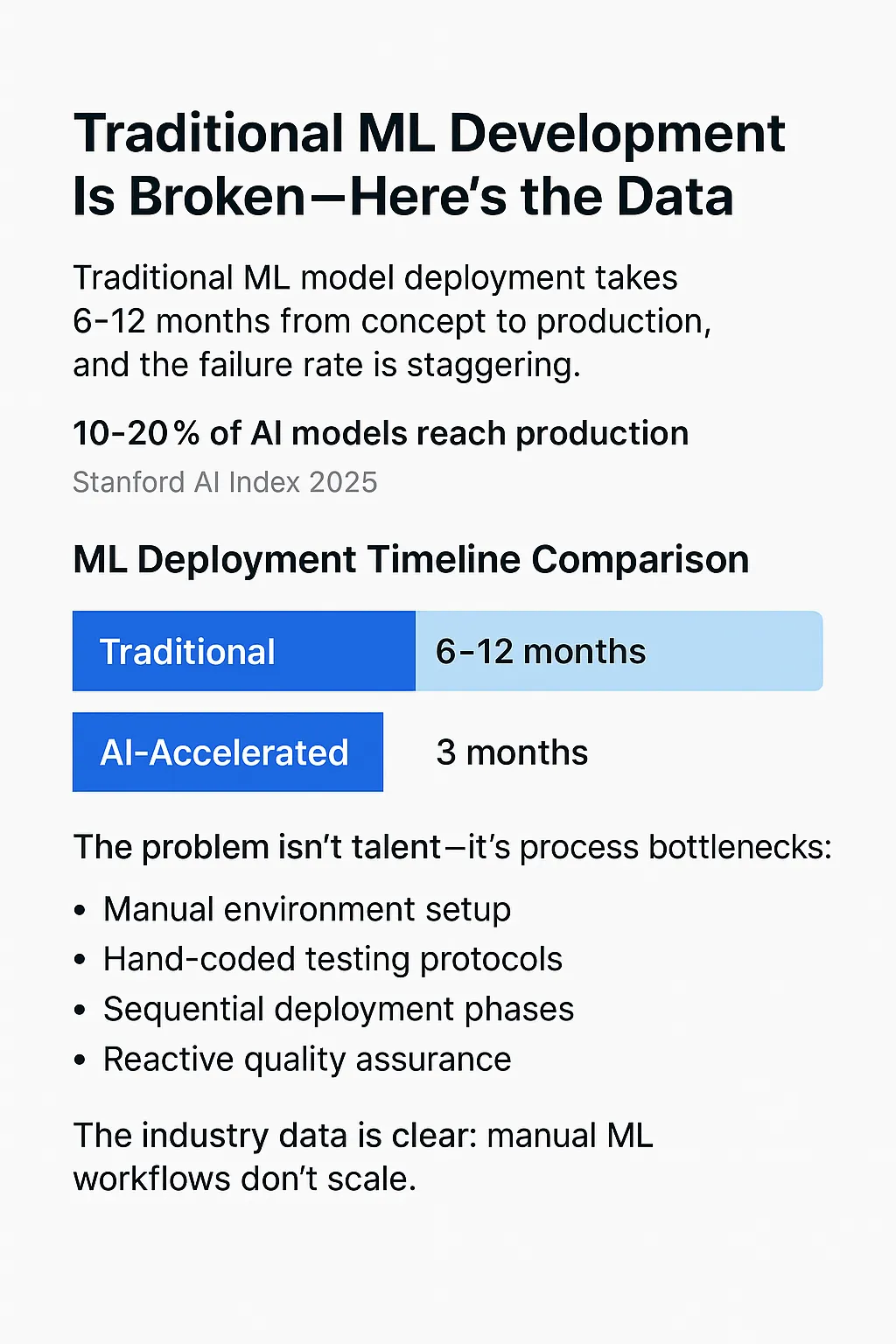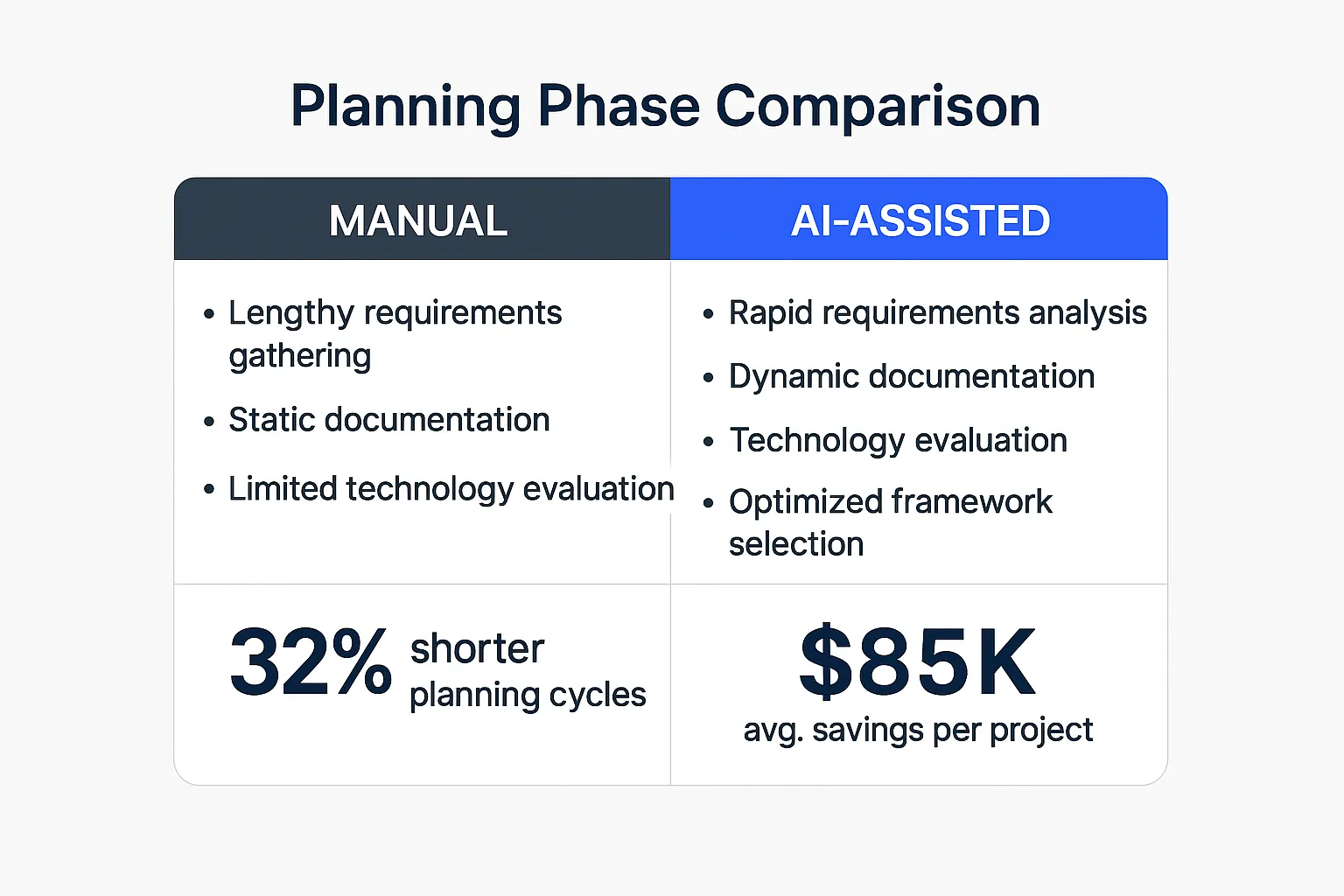Traditional ML development timelines are killing innovation. While 87% of data science projects never make it to production, smart organizations cut deployment from 6+ months to just 8 weeks using AI-accelerated workflows that automate everything from code generation to testing.
This isn’t about replacing your data scientists—it’s about amplifying what they can do. Companies using AI-powered development tools achieve 30% faster product launches while maintaining production-grade quality. I’ll show you exactly how to compress your ML timeline without sacrificing results.

Fig1. ML Deployment Timeline Comparison – Traditional vs AI-Accelerated
Traditional ML Development Is Broken—Here’s the Data
Traditional ML model deployment takes 6-12 months from concept to production, and the failure rate is staggering. Only 10-20% of AI models actually reach production, according to Stanford AI Index 2025, with 90% of initiatives stuck at the experimental stage.
The problem isn’t talent—it’s process bottlenecks:
- Manual environment setup: 2-4 days per deployment
- Hand-coded testing protocols: 70% of development time
- Sequential deployment phases: cascading delays
- Reactive quality assurance: bugs discovered post-launch
Global digital transformation achieves only a 35% success rate, with most initiatives failing to meet business objectives within planned timelines. A Fortune 100 bank’s analytics department reported an average 9-month gap between proof-of-concept and production, with only 15% of initiated models launching fully.
According to Ataccama’s 2025 Data Trust Report on financial institutions, while 99% of financial institutions are testing AI, just 3% have deployed it enterprise-wide—the gap driven by decades of mergers and legacy infrastructure requiring months of data preparation even after model training completes in weeks, with industry research tracking midmarket firms finding that scaled organizations moved projects from pilot to deployment in an average of 90 days, compared with nine months or more at enterprise-scale banks, validating the documented enterprise timeline delays where most institutions experience 9+ month gaps and low production adoption rates.
The industry data is clear: manual ML workflows don’t scale.
AI-Accelerated Development Delivers 60-70% Time Savings
Yes, you can actually deploy ML models in 8 weeks. AI-powered development tools reduce ML deployment time by 60-70%, compressing delivery from 24 weeks to 8-10 weeks in enterprise settings.
The acceleration comes from automating manual bottlenecks:
- Automated code generation handles data transformations
- AI-driven testing covers edge cases humans miss
- Intelligent deployment provisions infrastructure instantly
- Continuous monitoring catches issues before users notice
Automating code generation and testing workflows delivers 50% time savings and 40% fewer post-release bugs compared to traditional approaches.
“AI doesn’t replace developers—it amplifies their talent, accelerates delivery, and unlocks a new level of engineering excellence.” — Alistair Copeland, CEO of SmartDev
SmartDev’s VeryPay project integrated fintech AI systems into production in 7.5 weeks, achieving 30% faster delivery and zero critical post-launch bugs.
Week 1-2: AI-Powered Project Planning Eliminates Requirements Chaos
Smart planning starts with AI-driven requirements analysis. 72% of organizations now use AI-driven requirements analysis, up from 50% in 2022, because it eliminates the stakeholder confusion that typically extends planning phases.
Key AI Tools for Planning:
- Natural language processing extracts requirements from conversations
- Automated architecture recommendations reduce design time by 30-40%
- Technology compatibility checks prevent integration issues
- Performance prediction models optimize stack selection
AI algorithms analyze your data volume, latency requirements, and scalability needs to recommend optimal frameworks before development begins.
According to comprehensive developer AI stack analysis, successful AI-powered product teams implement technology stack selection and requirements analysis with AI-powered discovery tools reducing requirements gathering from traditional 3-6 week timelines to 1-2 weeks for framework evaluation through intelligent analysis of data volume, latency, and scalability parameters, achieving 32% reduction in time-to-market and $85K average annual savings per 10-person development team, while SmartDev’s comprehensive AI Tech Stack guide for 2025 confirms that selecting the right technology stack requires assessing data volume, scalability needs, and latency requirements through a structured evaluation process that identifies best-fit frameworks early, with intelligent automation substantially compressing timelines traditionally consumed by manual evaluation of frameworks like TensorFlow and PyTorch.

Fig2. Planning Phase Comparison – Manual vs AI-Assisted
According to Luan Nguyen, General Director at SmartDev: “AI-powered planning tools let us turn stakeholder dialogue into working specifications in hours, not days.” A fintech startup used SmartDev’s AI consulting to generate solution architecture within 48 hours, cutting the initial design phase by 60%.
Week 3-4: Automated Feature Engineering Cuts Development Time in Half
AI-assisted feature engineering eliminates the data preparation work that traditionally consumes 70% of a data scientist’s time. Automated feature selection cuts data prep time by 50-70%, while ML algorithms identify optimal feature combinations faster than manual analysis.
How AI Accelerates Model Development:
- Automated data preprocessing handles missing values and outliers
- Feature engineering pipelines generate and test combinations automatically
- Hyperparameter optimization explores thousands of configurations daily
- Model comparison frameworks evaluate performance across algorithms
Traditional hyperparameter tuning explores 50-100 configurations manually over several days. AI-powered systems explore up to 5,000+ configurations per day in leading platforms like DataRobot and H2O.ai, testing possibilities simultaneously while you focus on business logic.
Pull request turnaround accelerates 3x, and team productivity surges 20% under AI-assisted coding.
According to SmartDev’s internal reporting: “We saw model training cycles fall from 10 days to 2 using AI-prompted code generation and automated data engineering tools.” SmartDev’s VERA AI customer care solution was developed, tested, and iterated twice weekly, resulting in a production-ready model in 14 days.
Week 5-6: AI Testing Catches 98% of Edge Cases Traditional QA Misses
AI-driven testing changes quality assurance by generating comprehensive test suites that cover scenarios humans typically miss. AI-driven test case generation covers 98% of edge scenarios and reduces manual QA effort by 50%.
AI Testing Capabilities:
- Synthetic data generation for thorough model validation without privacy concerns
- Automated performance testing simulates production loads before deployment
- Real-time bias detection ensures fairness across demographic groups
- Security scanning identifies vulnerabilities in model code and dependencies
Up to 95% of vulnerabilities are detected during pre-deployment using advanced security scanning tools, while automated bias detection addresses compliance concerns proactively.
Real-time model performance tracking detects degradation immediately. 80% of new AI QA suites include real-time bias detection to ensure fairness across different demographic groups.
According to SmartDev’s engineering team: “We generate synthetic test data on demand, validate complex edge cases, and continually monitor for drift once live—our error rate is less than 0.6%.” SmartDev’s AI-enabled test automation suite detected 40% more bugs pre-release for a healthtech client while cutting manual validation hours in half.
Accelerate your AI journey — move from proof-of-concept to production in just 8 weeks with SmartDev’s AI-powered development expertise.
Learn how SmartDev’s AI engineering teams streamline model deployment pipelines for real-world scalability, reliability, and compliance.
Avoid common production pitfalls in MLOps — from data drift to cost inefficiencies — and unlock faster ROI through optimized AI delivery frameworks.
Read: The 8-Week AI Deployment Playbook for CTOsWeek 7-8: Infrastructure-as-Code Enables 4-Hour Production Deployment
Infrastructure provisioning becomes instantaneous with AI-orchestrated deployment. Infrastructure-as-code tools provision ML environments in 4-6 hours compared to manual setup times of 2-4 days.
AI-Powered Deployment Features:
- Automated containerization packages models with all dependencies
- Cloud-native architectures enable seamless scaling based on traffic
- Real-time monitoring detects model drift and performance issues automatically
- Self-healing infrastructure responds to issues before they impact users
Automated containerization eliminates environment mismatch issues in 95% of deployments, while AI-powered monitoring detects performance drift within 30 seconds with automated retraining pipelines triggering upon threshold breach.
“Cloud-native ML architectures allow us to scale up or down with zero downtime. Real-time alerts mean we catch issues before clients notice,” says Nguyen Le, COO at SmartDev. According to SmartDev’s internal reporting, real-time monitoring with automated alerting cut incident response time by 85% for a logistics provider, ensuring 99.99% model uptime over 6 months.

Fig3. AI-Powered Deployment Pipeline Architecture
Leading MLOps benchmarks target sub-five minute deployments and 99.9% system availability with automated scaling and live health checks.
Essential AI Tools and Team Structure for 8-Week Success
The right AI tools make the difference between success and another failed project. GitHub Copilot and similar AI coding assistants accelerate code development by 3x, while SmartDev reports 40% fewer post-release bugs and 20% productivity boosts using these tools.
Core AI Platform Stack:
- GitHub Copilot/Cursor: Accelerated code development
- DataRobot/H2O.ai: Automated ML model building
- MLflow/Kubeflow: MLOps pipeline orchestration
- Docker/Kubernetes: Containerized deployment
- Prometheus/Grafana: Real-time monitoring
Cross-functional teams with AI-native developers complete ML projects 2.5x faster than siloed groups.
Optimal Team Structure:
- DevOps engineers experienced in ML infrastructure
- Data scientists focused on model logic while AI handles implementation
- AI-native developers who understand intelligent automation tools
- MLOps specialists managing continuous integration/deployment
“The key to speed isn’t just automation—it’s AI-native skillsets and DevOps collaboration. Our AI practitioners deliver outcomes, not just code,” explains Alistair Copeland, CEO of SmartDev. SmartDev’s fintech delivery team delivered a digital wallet system to production in 8 weeks, achieving 4.8/5.0 client satisfaction and ISO/SOC2 compliance.
How AI Prevents the Top 5 ML Deployment Failures
Data quality issues kill more ML projects than any other factor, but AI-powered validation catches problems before they derail timelines.
AI Solutions for Common Pitfalls:
- Data Quality: Automated data validation detects quality issues in 90%+ of cases before training
- Scaling Issues: Predictive capacity planning prevents infrastructure bottlenecks in 96% of projects
- Performance Problems: Automated load testing identifies limits before production
- Security Vulnerabilities: AI-powered scanning catches issues during development
- Model Drift: Continuous monitoring with automated retraining pipelines
AI-powered data lineage tracking ensures result reproducibility in 99% of deployments, while intelligent error handling prevents pipeline failures from derailing project timelines.
According to SmartDev’s internal reporting: “Pipeline failures and out-of-memory errors are no longer showstoppers. AI-driven monitoring and error handling mean rapid recovery with no lost progress.” SmartDev’s AI pipeline validation flagged a critical schema error pre-training for an international retailer, preventing a failed launch and saving $250,000 in rework costs.
Measuring Success: KPIs That Prove 8-Week Deployment Works
Success metrics for AI-accelerated ML deployment focus on velocity, quality, and business impact. Companies using AI-accelerated workflows achieve 30% faster product launches, 40% fewer post-deployment bugs, and 50% reduction in manual QA effort.
Key Performance Indicators:
- Time-to-Value: Reduced from 6+ months to 8 weeks
- Development Costs: Decreased by 20-30% through automation
- Model Accuracy: Higher through systematic AI-assisted optimization
- Bug Rates: 40% reduction in post-deployment issues
- Team Productivity: 20% increase in delivery velocity
Average time-to-value for ML models drops from 6+ months to 8 weeks using AI-accelerated workflows. According to Gartner’s latest forecast, by 2028, 80% of generative AI commercial applications will be developed on existing data management platforms, reducing development complexity and cutting delivery time in half through unified platform approaches that consolidate data management, model development, and deployment into integrated workflows, while academic research synthesizing MLOps practices and deployment studies demonstrates that applying MLOps principles significantly improves the efficiency and reliability of deploying ML models in production environments, with most organizations reporting between 8 and 90 days to deploy models when leveraging automation, continuous integration/continuous deployment (CI/CD) pipelines, versioning, and monitoring—compared to traditional 6+ month deployment timelines for organizations lacking structured MLOps frameworks
.
According to Ha Nguyen Ngoc, Marketing Director at SmartDev: “Business ROI isn’t just theoretical—AI lets us measure reduced costs, faster launch, and superior quality, driving real revenue impact.” According to SmartDev’s internal reporting, VeryPay’s 8-week build delivered a $1.2M reduction in annual operational costs and lifted payment accuracy by 13%.

Fig4. Before and After AI Implementation
Scaling Success: Building Repeatable 8-Week Deployment Processes
Building sustainable AI-accelerated workflows requires continuous learning and process optimization. Over 80% of top-tier firms implement continuous learning and monthly AI workshops to ensure expertise remains current with rapidly advancing AI capabilities.
Scaling Strategy Components:
- Standardized templates and reusable components
- Regular process optimization incorporating new AI capabilities
- Continuous training programs for team skill development
- Established monitoring and maintenance processes
Standardized templates and reusable components speed up repeat delivery by 25-40% across projects, while proven methodologies enable faster subsequent project delivery.
“Sustainable AI workflows aren’t a one-time fix—they require ongoing upskilling and process optimization with every project cycle,” explains Ha Nguyen Ngoc. According to SmartDev’s internal reporting: Training programs and process upgrades enabled clients to finish three subsequent ML deployments each in under 6 weeks versus 12+ weeks before adopting AI-accelerated methodology.
Firms scaling with reusable frameworks and process standardization report up to 3x acceleration on follow-up machine learning initiatives, sustaining >99% uptime and rapid retraining responsiveness.
Start Your 8-Week ML Deployment Today
The organizations moving fastest aren’t waiting for perfect AI tools—they’re implementing proven AI-accelerated workflows right now. Every month you delay costs opportunities and competitive advantage.
Your next step? Start with SmartDev’s AI consulting services to assess your current ML development process and design an 8-week acceleration roadmap tailored to your specific requirements.
Ready to compress your ML timeline from months to weeks? Connect with SmartDev’s AI development experts to discuss your deployment challenges and timeline requirements. The initial investment in AI-native processes pays compound returns across every subsequent project.
Learn more about SmartDev’s proven AI-accelerated methodology and join the organizations already deploying ML models in weeks, not months.








